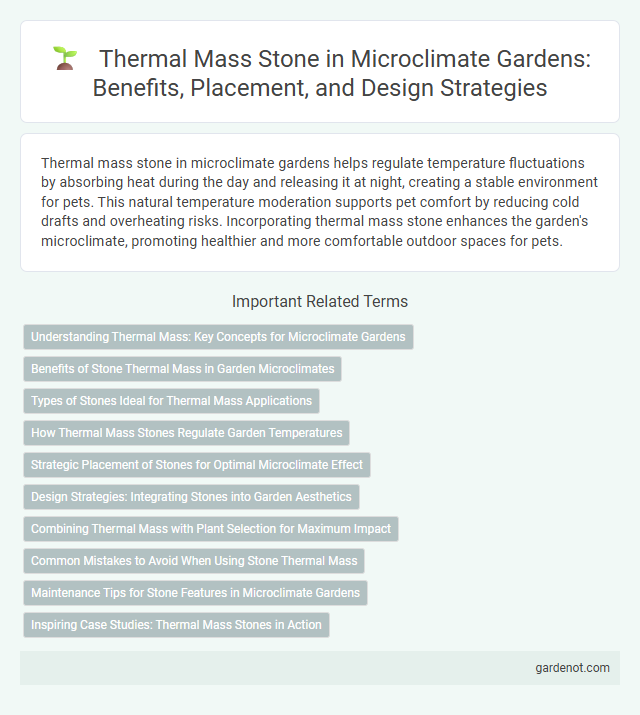Thermal mass stone in microclimate gardens helps regulate temperature fluctuations by absorbing heat during the day and releasing it at night, creating a stable environment for pets. This natural temperature moderation supports pet comfort by reducing cold drafts and overheating risks. Incorporating thermal mass stone enhances the garden's microclimate, promoting healthier and more comfortable outdoor spaces for pets.
Understanding Thermal Mass: Key Concepts for Microclimate Gardens
Thermal mass in microclimate gardens refers to materials like stone that absorb, store, and slowly release heat, stabilizing temperature fluctuations and creating a more favorable environment for plants. The high density and specific heat capacity of stone enable it to moderate diurnal temperature swings, protecting plants from frost and excessive heat. Strategically placing thermal mass stones near plants enhances microclimate control by maintaining consistent soil warmth and reducing stress on sensitive vegetation.
Benefits of Stone Thermal Mass in Garden Microclimates
Stone thermal mass in garden microclimates enhances temperature regulation by absorbing heat during the day and releasing it slowly at night, promoting a stable environment for plants. This thermal buffering reduces temperature extremes, extending the growing season and improving plant resilience against frost. Incorporating stone materials also contributes to energy efficiency by minimizing heat loss and supporting sustainable gardening practices.
Types of Stones Ideal for Thermal Mass Applications
High-density stones such as granite, basalt, and sandstone are ideal for thermal mass applications in microclimate gardens due to their ability to absorb and retain heat efficiently. These materials slowly release stored warmth during cooler periods, helping to moderate temperature fluctuations around plants. Limestone, while less dense, is also commonly used because of its availability and moderate thermal storage capabilities.
How Thermal Mass Stones Regulate Garden Temperatures
Thermal mass stones absorb heat from sunlight during the day, storing energy that gradually releases warmth into the garden environment as temperatures drop at night. This natural heat regulation stabilizes temperature fluctuations, protecting plants from extreme cold and heat stress. Using thermal mass stones creates a microclimate that promotes healthier growth by maintaining consistent warmth in garden spaces.
Strategic Placement of Stones for Optimal Microclimate Effect
Strategic placement of thermal mass stones in a microclimate garden enhances temperature regulation by absorbing heat during the day and releasing it at night, creating a stable environment for plant growth. Positioning stones on south-facing slopes maximizes solar exposure, while clustering them near windbreaks reduces heat loss and shields tender plants from cold gusts. Integrating stones around planting beds also improves soil warmth and moisture retention, promoting a resilient and productive garden microclimate.
Design Strategies: Integrating Stones into Garden Aesthetics
Thermal mass stones in microclimate garden design absorb and retain heat, moderating temperature fluctuations and creating a stable environment for plants. Strategic placement near planting beds or seating areas maximizes their heat-radiating properties, enhancing comfort and promoting plant growth. Incorporating varied stone sizes, textures, and natural colors seamlessly blends functionality with aesthetic appeal, enriching the garden's visual and thermal dynamics.
Combining Thermal Mass with Plant Selection for Maximum Impact
Thermal mass stone in microclimate gardens enhances temperature regulation by absorbing heat during the day and releasing it at night, creating a stable environment for plants. Selecting heat-tolerant, drought-resistant species like succulents or Mediterranean herbs complements the thermal mass, optimizing water retention and reducing stress. Strategic placement of these plants near stone surfaces maximizes heat absorption and radiative warmth, promoting healthier growth and extended growing seasons.
Common Mistakes to Avoid When Using Stone Thermal Mass
Incorrect placement of thermal mass stone can lead to inefficient heat absorption and release, reducing its effectiveness in stabilizing microclimate temperatures. Using stones with low heat capacity or improper thickness fails to store sufficient thermal energy, causing temperature fluctuations. Neglecting moisture management around stone thermal mass can result in mold growth and structural damage, undermining the garden's microclimate benefits.
Maintenance Tips for Stone Features in Microclimate Gardens
Thermal mass stone features in microclimate gardens require regular cleaning to prevent moss and algae buildup, which can retain moisture and cause deterioration. Inspect stones for cracks or chips periodically to address damage early and avoid structural issues. Applying a breathable sealant helps protect the stone while maintaining its ability to absorb and release heat effectively.
Inspiring Case Studies: Thermal Mass Stones in Action
Thermal mass stones in microclimate gardens regulate temperature fluctuations by absorbing heat during the day and releasing it at night, enhancing plant growth and extending growing seasons. Case studies in Mediterranean and desert gardens demonstrate how strategically placed thermal mass stones create favorable microclimates, improving moisture retention and reducing irrigation needs. Innovative designs in urban rooftop gardens utilize thermal mass stones to mitigate heat stress, promoting sustainable urban agriculture.
Thermal mass stone Infographic

 gardenot.com
gardenot.com